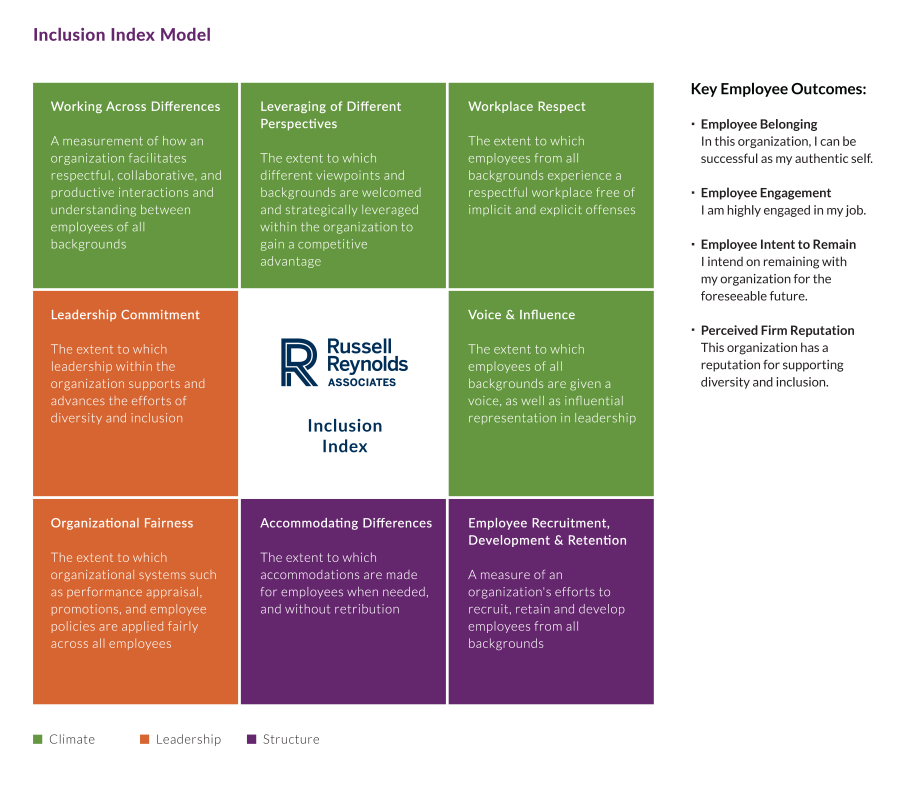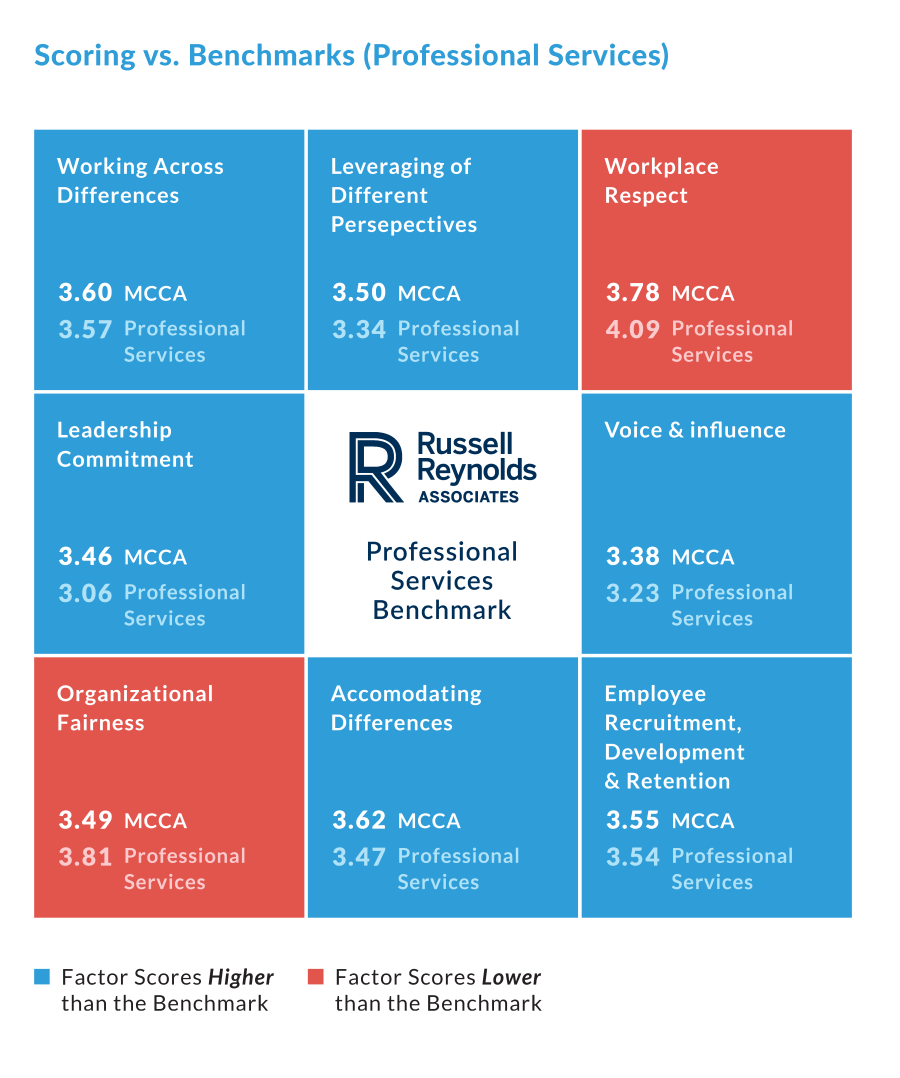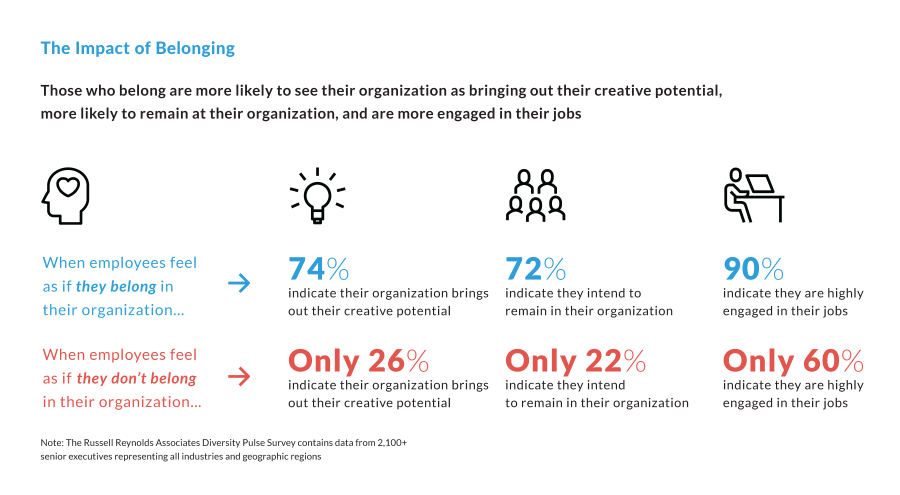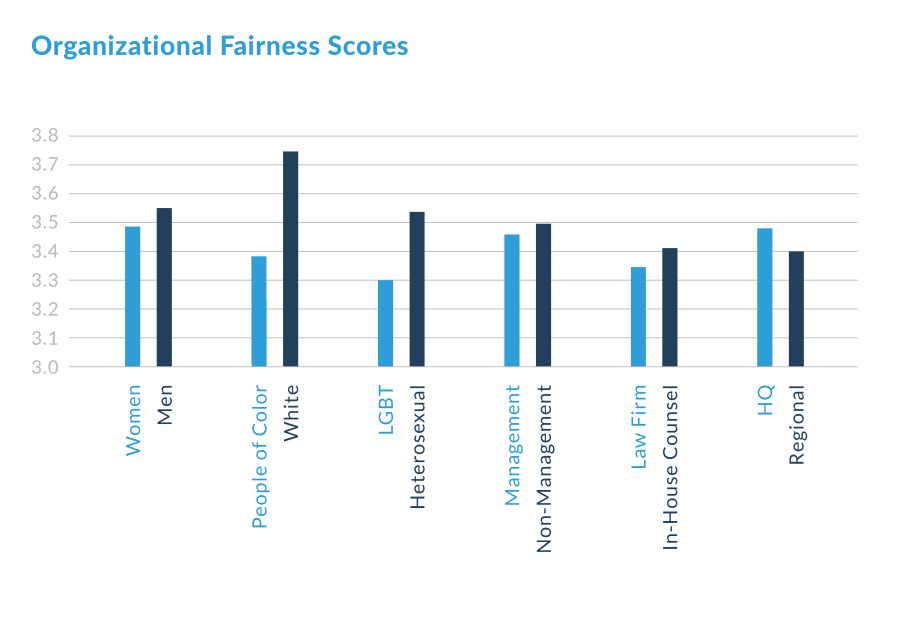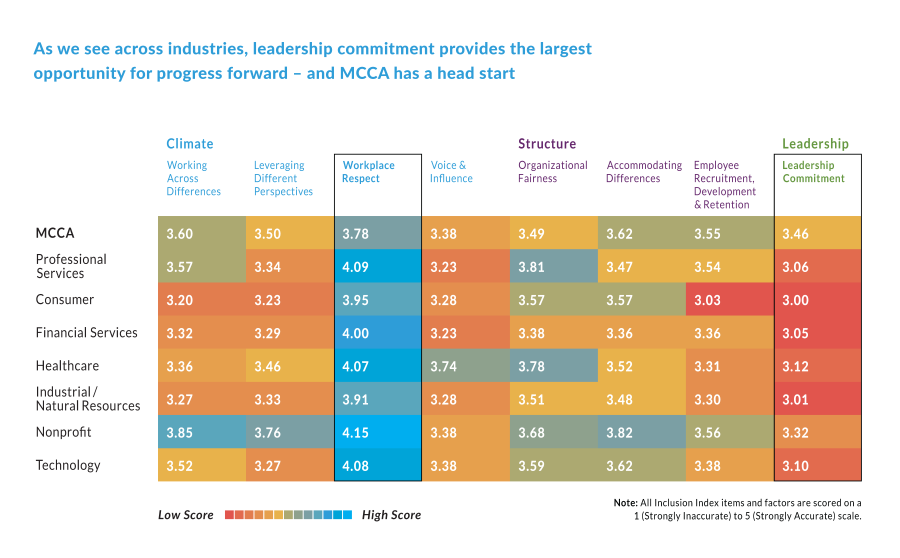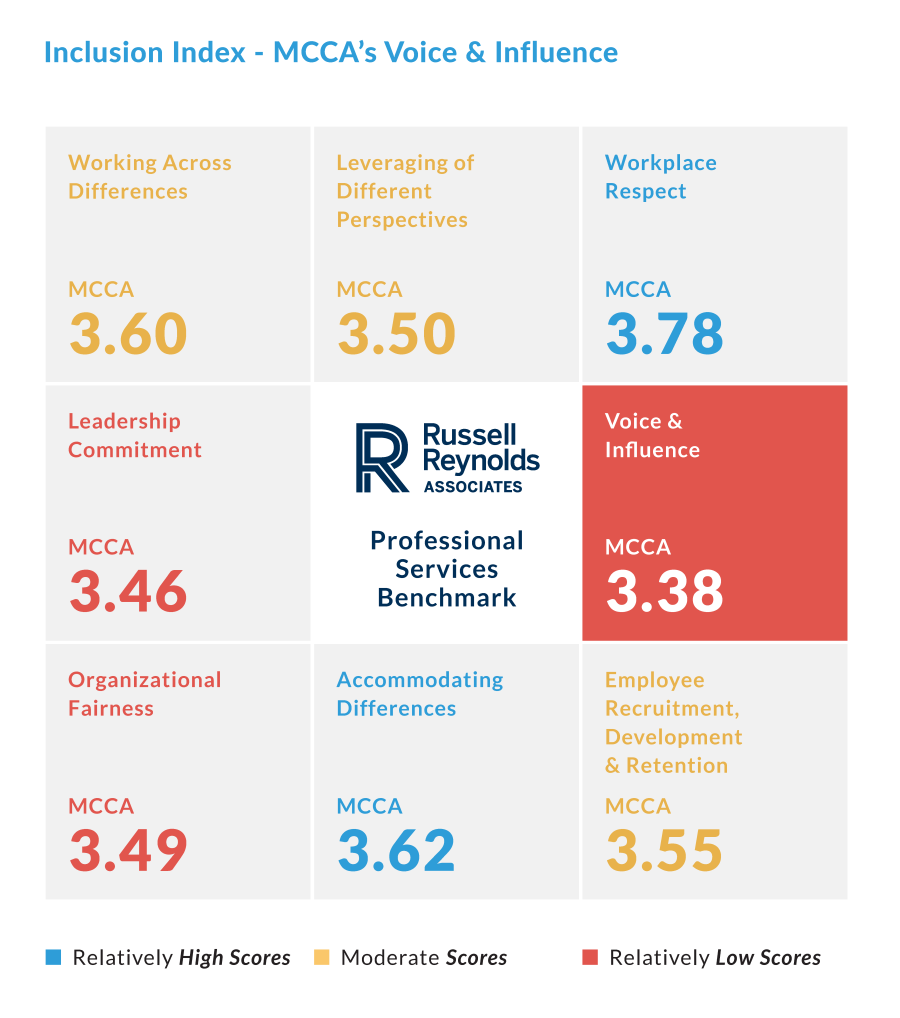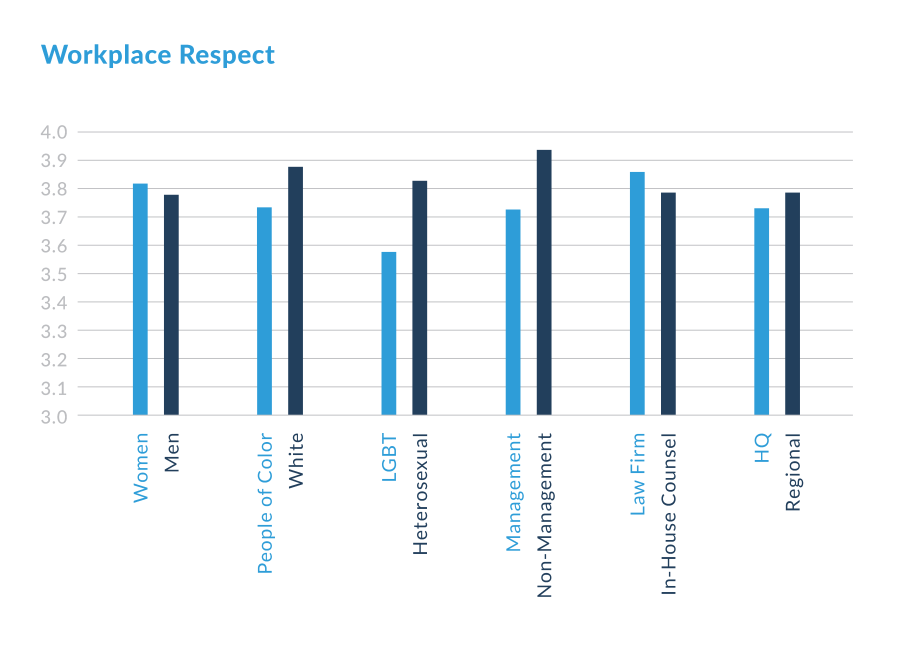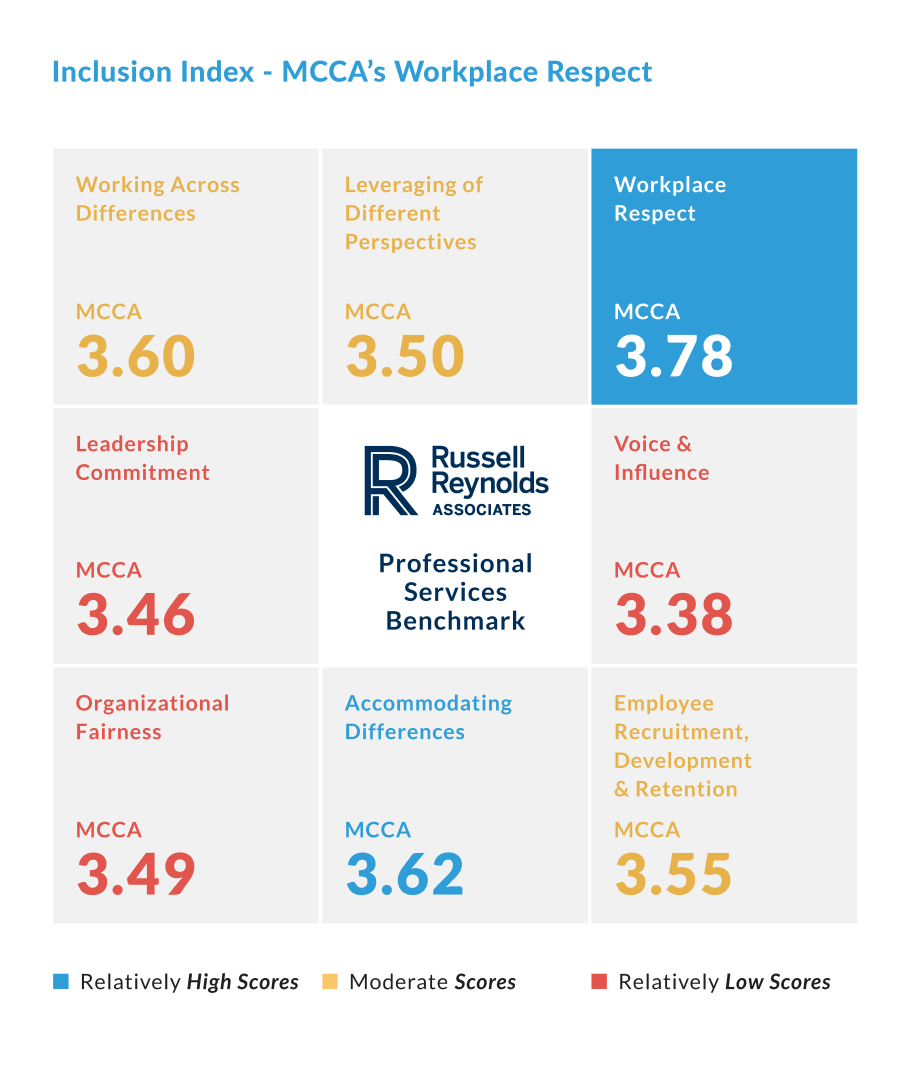Tina Shah Paikeday leads global D&I Consulting Services at Russell Reynolds Associates and Jean Lee is president and CEO of the Minority Corporate Counsel Association (MCCA). This post is based on a joint memorandum from Russell Reynolds and MCCA by Ms. Shah Paikeday, Ms. Lee, Jacob Martin, Cynthia Dow, and Sophia Piliouras.
The Slow Road to Diversity
For decades, the legal profession has attempted to hire and recruit more diverse talent, yet progress has been slow. Although people of color (including those who identify as Asian, Black or African American, Hispanic, or Latinx) comprise a growing number of law firm associates, they remain significantly under-represented at higher levels. Between 2007 and 2017, the proportion of equity partners who are people of color grew from 6 percent to 9 percent, according to MCCA/Vault data, even though under-represented attorneys have accounted for around 20 percent of all law firm hires in each year during that time frame. The situation is particularly acute for women of color, who comprise just 3 percent of equity partners—up from less than 2 percent in 2007.
Many factors contribute to these statistics, but disproportionately high (and rising) attrition rates for attorneys who are people of color are a crucial one. [1] Last year, people of color comprised 17 percent of all attorneys, yet accounted for 22 percent of all departures. To truly accelerate diversity in their ranks, it’s clear that lawyers need new strategies.
Recent research has put the spotlight on inclusion as a necessary ingredient to successful diversity. Inclusion focuses on actively embracing diverse perspectives and changing the culture to reflect them, rather than simply hiring diverse employees and expecting them to fit into the existing culture. Importantly, any leader or employee can contribute to inclusion, regardless of background or demographic.
Russell Reynolds Associates (RRA) research shows that when employees consider their leaders inclusive, they are more likely to want to remain with the company, along with other positive results.
Yet the measure of a culture’s inclusivity ultimately lies with employees, and in particular, with those who have traditionally been marginalized.
To better understand how attorneys feel about their organizations’ diversity and inclusion (D&I) efforts, the Minority Corporate Counsel Association (MCCA) partnered with RRA in 2018 to launch an Inclusion Index survey. More than 600 attorneys from both law firms and corporate legal departments, and across all demographic categories—yielding a robust set of insights.
In brief, the Inclusion Index results reveal that law firms and corporate legal departments cultivate a number of positive cultural elements. However, low scores in the belonging category raise concerns that many attorneys do not feel they can be themselves at work, but rather have to adapt to the existing culture to succeed.
Methodology:
The MCCA/RRA Inclusion Index survey was completed between May and August 2018 by 661 respondents. Respondents were asked to provide responses to 53 items related to the organizational culture surrounding diversity and inclusion in their workplaces. Responses were reported on a scale ranging from 1 to 5. Averages were calculated for each of the 8 inclusion index factors and the following human capital outcomes: Belonging, Employee Engagement, Intent to Remain, and Firm Reputation.
Based on the demographic information provided by 209 respondents:
- 54% were female, 44% were male, 2% preferred not to share
- 62% identify as a person of color (Asian, Black or African
American, Hispanic, or Latinx), 38% identify as white - 85% identify as heterosexual, 12% identify as lesbian, gay or bisexual, 3% prefer not to share
- 51% work for in-house counsel, 38% work for a law firm, 11% work for other
How the MCCA/RRA Inclusion Index Works
The MCCA/RRA Inclusion Index measures a number of factors that help surface respondents’ feelings about their workplaces and pinpoint potential solutions. This Index is based on responses to approximately 50 questions that ask respondents to rate how much they agree or disagree with statements such as: The organization’s policies allow me to balance personal and professional commitments, Promotion decisions are free of bias, and Specific goals are set for leadership related to diversity and inclusion.
At a high level, the survey responses measure an employee’s sense of belonging to their organization, as well as derivative measures including engagement, intent to remain and perceived firm reputation.
To make the results actionable, we then correlate the outcomes to specific survey responses in eight distinct categories and map these drivers to the three major areas of D&I strategy: Climate, Structure, and Leadership.
By pinpointing opportunity areas, the Index allows organizations to invest in the specific items that will yield the most meaningful improvements.
Five Key Takeaways From The 2018 MCCA/RRA Inclusion Index
- Overall, MCCA member employers perform well on inclusion measures compared to other professional services
- However, many MCCA members report they don’t feel a strong sense of belonging at their workplace, a key outcome factor that can influence employee engagement, creativity and intent to remain.
- The main factor behind the low belonging scores is the sense that law firms and corporate legal departments allow bias to creep into hiring and promotion processes, limiting opportunities for people of color (including those who identify as Asian, Black or African American, Hispanic, or Latinx).
- People of color and those identifying as LGBT give their employers significantly lower ratings than others on each of the MCCA/RRA Inclusion Index’s eight categories.
- The path forward requires top leaders to play an active role in defining, modeling and coaching inclusive leadership behaviors throughout the organization.
Key Findings from the MCCA/RRA Inclusion Index
There are a number of ways to understand the results of the MCCA/RRA Inclusion Index. One lens is to compare legal employers to other professional services firms. By this measure, they score relatively well, outperforming the benchmark on six of eight factors. Two notable areas of strength include Working Across Differences and Accommodating Differences, which speak to how well a culture can adapt its collaboration styles as well as its policies to the diverse needs of today’s attorneys. Considering the stereotypical rigid law firm culture, these findings suggest the legal profession has come a long way in these areas.
Another lens for viewing the results is to look at key outcomes to get a general sense of how attorneys feel about their employers. Here, we find that belonging scores are low, and exceptionally low for people of color. Why does belonging matter? While feelings are invisible, their impact on work is unequivocally tangible. RRA research shows employees who feel like they belong consider themselves more engaged and creative at work, as well as more inclined to stay with their current employers, than employees who feel like outsiders.
“[Dialogue around diversity and inclusion won’t get comfortable without practice. They need to keep fostering situations that may be uncomfortable but are friendly and respectful and engaging.”
—Hispanic Male; Workplace Respect
“I find there is a big disconnect between policy and what takes place in practice, likely due in part to unconscious bias—i.e., those in power tend to gravitate toward and promote those who are most like them, and firm management is not very diverse.”
—East Asian Female; Organizational Fairness
These results are similar to what we see when employees consider their leaders inclusive, because the net result is the same: when people feel they can be successful at work by being themselves, without the constant need to assimilate and adapt to a dominant (and different) culture, they are more likely to want to engage and remain.
What drives belonging? Our research finds that Organizational Fairness is the factor that has the single greatest impact on belonging for attorneys. Low scores in this category suggest employees perceive leaders are not making hiring and promotion decisions fairly and equally. Instead, leaders are seen to be relying on longstanding networks and personal familiarity rather than merits alone.
Not surprisingly, it is one of the lowest-scoring categories for attorneys, as well as one of the two categories in which legal employers underperformed the industry benchmark.
These feelings of inequity—and often anger—come through in the open-ended survey responses to questions such as What can leadership at your firm do to help create a more diverse and inclusive culture?
Many commenters noted the need for more diversity in legal leadership roles, and their widespread frustration with failed efforts to promote more women and people of color to the partner level. As one female attorney said, leadership should “acknowledge the elephant in the room, which is that despite recruiting a diverse associate pool at the beginning, the firm utterly fails to promote diverse individuals,” as its 2018 partner class “was 100% white male.”
Targeted efforts to address the broken process, such as training, sponsorship and mentorship, were a common suggestion. “Leadership should actively focus on the skill development and promotion of attorneys of color, particularly in light of implicit biases that exist in the firm. For example, attorneys of color are less likely to have as much client contact or informal relationships with senior associates and partners,” commented a Black female attorney.
While racial and ethnic diversity was a primary focus, a number of commenters pointed out that law firm culture also shuts out other kinds of diversity. “This goes beyond race and gender; there is a specific “type” that is predominant here, and some very talented individuals who may not be perceived to fit the “type” (but who are nonetheless exceptional lawyers) sometimes get passed over,” noted an LGBT male attorney working for a law firm.
The data from diverse groups bear out these perceptions. Attorneys who identify as people of color (those who identify as Asian, Black or African American, Hispanic, or Latinx) rate Organizational Fairness much lower than those who are white.
Attorneys who identify as LGBT have the lowest absolute score and much lower than those identifying as heterosexual. Law firm employees also rate fairness lower on average than those working at corporations, though both averages are low in absolute terms. Somewhat surprisingly, the difference between men’s and women’s scores are fairly minimal, suggesting women do not uniformly perceive inequity in hiring and promotion processes. This may be due to relative representation levels, as women now make up close to half of associate classes and more than 20 percent of all equity partners, compared to people of color who collectively hold half as many associate positions and 9 percent of equity partner titles.
Most firms have strict policies in place regarding hiring and promotion discrimination, yet clearly, they are not enough. Peeling back the layers of a related and similarly low-scoring category, may help paint a fuller picture of what is happening and how to address it.
Low Leadership Commitment scores suggest attorneys feel their leaders are simply paying lip service to diversity and inclusion but are not personally invested in advancing it. This finding may be frustrating to the many general counsels and law firm partners involved in MCCA who have committed significant time, energy and emotion to advancing this issue (see Leading by Example section). One potential reason for this disparity: senior leaders may do their part, but do not hold others accountable for doing theirs, resulting in uneven commitments to D&I across business units or management levels.
“Consistency is key,” said a law firm attorney. “There are certain leaders in the organization who are staunch supporters of diversity in the workplace, and who do whatever they can to foster an inclusive culture. However, there are other leaders within the organization who do not seem to place any real value in building a diverse and inclusive culture, and who seem to bring a great deal of implicit bias to the organization.”
Many commenters noted a commitment gap between the top and middle management levels. One female attorney believes her legal department’s senior leaders are doing all they could to foster diversity and inclusion, but that they need to “work with middle management to be as engaged and as inclusive as” they are.
“Creating full and fair opportunities for the existing workforce to interview for and move into new positions will increase morale and trust in senior management.”
—White Male; Organizational Fairness/Leadership Commitment
This commitment gap is a common problem for nearly every organization we advise, for a simple reason: Middle managers typically find it less risky to promote those who conform to the culture than those who are different. The solution starts with top leadership creating a stronger mandate (and incentives) for middle managers to cultivate diversity in hiring, promotions, and development opportunities. Senior leaders can also take more ownership of this problem rather than placing the burden on middle managers by engaging in skip-level sponsorship.
While there is clearly work to be done, it is important to note that legal employers score significantly higher on Leadership Commitment than organizations in any other sector. With this context, we can fairly consider the leadership commitment relatively strong, if not perfectly understood by survey respondents. It is also a critical area to build upon to improve the culture of the legal profession.
Another Inclusion Index factor that is closely related to Organizational Fairness—and the third of the three low-scoring categories—is Voice & Influence. Low ratings here mean employees feel they do not have a say in how decisions are made, or effective methods to express their concerns to management. This can also stem from perception that senior leadership does not reflect the demographic makeup of employees and by extension, does not represent their best interests.
All of those themes came through in attorneys’ comments. Many simply wanted a chance to share their perspectives openly. “Open up formal opportunities not only for anonymous (e.g., via survey) feedback, but brown bag lunches, etc. where dialogue around diversity and inclusion IS the agenda,” said one LGBT female working for in-house counsel. Others centered on the need to foster more diversity in leadership to ensure fair representation and proposed alternate ways for management to hear from diverse employees before making decisions. One Black male attorney suggested interactive town hall meetings to discuss proposed policy changes, “not only to let employees know of them, but to [give them a chance to] chime in and make [management] aware of the difficulties that these new polices can create, as diverse cultures are rarely taken into account in these changes.”
Similar to other categories, we see exceptionally low scores for people of color and those identifying as LGBT, but relatively similar scores for men and women. The fact that managers (typically middle managers in this case) felt they had less voice & influence than others may shed light on the perception that they are less committed to D&I than they should be. Middle managers may feel that to keep their own career prospects on track, they have to be more careful and take fewer risks in how they advocate for employees, particularly for diverse ones.
Notably, in this category MCCA members scored lower than non-MCCA members, suggesting MCCA has a powerful role to play in advocating for those who feel their perspectives and opinions fall on deaf ears at work.
Despite these challenges, the MCCA/RRA Inclusion Index revealed some bright spots in legal culture. Across all categories, Workplace Respect—a climate factor—is the highest-scoring category. This means is that employees feel their colleagues treat them with respect, and that offending others is not tolerated. They interact with each other in a similar manner, regardless of colleagues’ backgrounds, and avoid any overt discrimination or bias.
“Our organization fosters an inclusive culture through training, cultural themed activities, encouraging people to speak up, encouraging people to share their ideas and collaborate with each other.”
–White Female; Working Across Differences/Leveraging Different Perspectives
This sense is reinforced by high scores in related categories such as Accommodating Differences, which refers to offering accommodations such as flexible hours to employees when needed and without retribution and Working Across Differences, which refers to organizational norms around collaborations and interaction.
Positive comments from attorneys underscored these ratings. “Our organization fosters an inclusive culture through training, cultural themed activities, encouraging people to speak up, encouraging people to share their ideas and collaborate with each other,” said one female attorney. Others mentioned mentorship, events with outside speakers, and affinity groups (with budgets) as ways their firms were promoting respect. “When it comes to D&I, this firm puts
its money where its mouth is,” said one attorney.
Respect is a foundational aspect of inclusion and can be very helpful for maximizing the power of diversity. However, similar to other elements of the Inclusion Index, when we look at the data for diverse groups, historically-marginalized groups again rate their organizational cultures lower on this factor than others.
Moving Forward: How to Unlock the Power of Diversity Through Inclusive Leadership
Overall, the results of the MCCA/RRA Inclusion Index suggest the legal profession has the right rules and policies to avoid actively discriminating against or offending its employees, and many top leaders sincerely promote the value of diversity and inclusion. However, law firm partners and corporate general counsels still need to connect policy to practice by holding leaders at all levels accountable for fostering diversity and inclusion. Crucially, they need to train and incentivize middle managers to surface and embrace differences, both in day-to-day interactions as well as hiring and promotion decisions.
To make progress, leaders in the legal profession should focus their efforts on promoting inclusive leadership as well as diversity itself.
What is inclusive leadership? RRA defines inclusive leadership as: a set of proactive behaviors that leverage the unique attributes of each person in the workplace with the goal of enhancing overall performance.
Currently, however, it is relatively rare. Only 40 percent of executives believe their leadership is held accountable for fostering an inclusive culture and only 35 percent said their leadership considers inclusive behaviors as promotion criteria for leaders, according to RRA’s recent D&I Pulse survey.
Inclusive leaders excel in four key areas. They bring awareness and clarity to problem areas, they practice courageous accountability to help resolve those problems, they empower others, and they foster innovative collaboration to unlock the unique contributions of each person in a group.
RRA’s Inclusive Leader model further breaks out each of these four competencies into intrapersonal dimensions (related to how a leader self-regulates) and interpersonal dimensions (related to how a leader interacts with others).
These four categories help inform some specific action items for the legal profession, based on the Inclusion Index data:
Awareness and Clarity
Core actions associated with this competency include gathering information about D&I pain points from the organization, creating safe spaces for dialogue on differences, and proactively soliciting input from diverse viewpoints.
These actions can directly address low scores on Voice & Influence, as well as concerns around how well diverse viewpoints are represented in executive leadership decisions.
Ironically, high levels of Workplace Respect may present some challenges in implementing them. Well-meaning leaders are often reluctant to initiate conversations on diversity because they are afraid of making people feel different. Yet, survey comments highlight the fact that diverse employees want their differences to be acknowledged.
Straight Talk on Raising Awareness: Advice from MCCA/RRA Inclusion Index respondents
“Leadership should first be willing to even have meaningful dialogue around diversity and inclusion, outside of standard corporate speech.”
– Black male LGBT attorney
“[Dialogue around diversity and inclusion] won’t get comfortable without practice. They need to keep fostering situations that may be uncomfortable but are friendly and respectful and engaging.”
– Hispanic male attorney
“They have started an initiative around ‘courageous conversations’, which I think is a great start and there should be more of throughout the organization.”
– Hispanic female attorney
Courageous Accountability
Core actions associated with this competency include leaders setting goals to address the D&I pain points that dialogues have surfaced and making visible personal commitments to stick with them. This process may involve creating new policies, setting new goals, or hiring new talent to oversee D&I.
Such measures could address many of the concerns raised regarding inequity in promotions, as well as the inconsistency in D&I commitment from leader to leader. Based on many of the survey comments, it would also go a long way to increasing the respect diverse employees have for their firms.
Straight Talk on Accountability: Advice from MCCA/RRA Inclusion Index respondents
“To foster an inclusive culture, the organization would need to make that a goal. There are no goals of diversity, written or voiced. Then, when the goal is made, they can make strides to hire and include people of diverse backgrounds…”
– Black female attorney
“Tie partner compensation to success in hiring, retaining and promoting diverse talent.”
—Black male attorney
Empowering Others
Core actions include leaders taking time to understand each direct report’s strengths, weaknesses, and career goals and connecting them to resources that can help them achieve those goals. These resources can take the form of mentorship or sponsorship within the firm, or connection to external training or education.
For the legal profession, this would involve partners and corporate leaders taking the time to build relationships across de facto boundaries and push others to do so as well. Based on the Inclusion Index data and comments, many leaders simply need to tap into resources that are already in place.
Straight Talk on Empowering Others: Advice from MCCA/RRA Inclusion Index respondents
“We have a minority group that none of the white employees know about. We need to bring more collaborations and celebrations highlighting diverse cultures to the forefront of firm life”
—Black female attorney
“Leadership could actively participate more in D&I events. They do a good job of encouraging these efforts, but they don’t all participate or actually engage with the department in these events.”
—Female, in-house counsel
Innovative Collaboration
With a better understanding of each team member’s potential, leaders leverage complementary strengths and styles to maximize team outcomes. Specific steps might include intentionally building diverse or cross-functional teams or adjusting meeting styles to ensure full participation.
Promoting the value of unconventional collaborations can help allay fears that middle managers may have around diversifying their project staffing and help them—and others—see the benefits in bringing together a wide array of perspectives. And as these benefits become more tangible, they create momentum around the mandate for diverse teams, making every dimension of inclusive leadership easier to tackle.
Straight Talk on Innovative Collaboration: Advice from MCCA/RRA Inclusion Index respondents
“‘Walk the walk’ by hiring more diverse employees, staffing them on significant/plum assignments, and promoting diverse employees. Also, be publicly outspoken about diversity and inclusion, and take a real position on racism, xenophobia and discrimination in the firm’s footprint.”
– East Asian female attorney, law firm
“[It would be great to have] more encouragement of senior attorneys (particularly rainmakers and those in leadership positions) to adapt styles/ communications to diverse associate pools. For example, actively soliciting input from associates who, culturally, are accustomed to “speaking only when spoken to” when it comes to interacting with authority figures.”
—Southeast Asian male, law firm
“Celebrate a bigger variety of accomplishments. Appreciate different ways of improving the organization’s bottom line (encouraging peers may increase revenue as much as increasing one’s own billable hours).”
—White female lawyer, law firm
Leading by Example
As a group, MCCA board members rate significantly above average on every measure of inclusivity, based on feedback from their staff members as well as self-assessments and interviews based on RRA’s Inclusive Leadership diagnostic.
This commitment to creating inclusive cultures came through in RRA’s interviews with these board members. Many make it a point to share their personal stories to encourage employees to share about their own backgrounds. “I talk openly about my own identity and my Filipino heritage because I want others to feel comfortable showcasing [their identities] and being their authentic selves in the workplace,” said Joseph Centeno, outside general counsel & assistant corporate secretary for Buchanan Ingersoll & Rooney PC.
“You have to know your audience to get them to engage,” agreed Damien Atkins, SVP, general counsel and secretary for The Hershey Co. To that end, he aims to “show vulnerability first, so I can connect with employees on a personal level and show that it’s safe for them to open up to me and tell me more about themselves.” The important thing, he added, is “to drive the issue around others and make everyone become a part of the conversation.”
After learning more about their colleagues, many MCCA board members go out of their way to empower them. “At points in my career, I’ve felt like an outsider and it’s a horrible thing to feel that way,” said Sandra Leung, EVP and general counsel for Bristol Myers-Squibb Co. As a result, she is proactive about finding ways to promote belonging. For example, she asked an LGBT executive to talk about authentic leadership at an internal global leadership meeting—an opportunity which then catalyzed the executive’s willingness to share her LGBT identity more broadly and become an advocate for others.
MCCA board members are also passionate about rooting implicit biases out of hiring and promotion processes. Ricardo Anzaldua, general counsel and corporate secretary for Freddie Mac, redesigned the way top talent was selected to be part of his firm’s Leadership Academy to reduce favoritism in the process. A key feature: going beyond managers’ recommendations. “We consulted with managers, but the more important element was a survey that went to the clients of the attorneys, and surveys of their peers,” Anzaldua said. “We tried to get that 360 degree view and at least 20 data points on each professional.” The result was that the employees who were chosen were proportionally representative of diversity within the candidate pool.
A side benefit, added Anzaldua, was the ability to use the survey results to cross-check managerial assessments. “We wanted to identify how managers made their decisions and how we could address them if they reflected biases.”
Finally, looking for ways to develop diverse colleagues all along the pipeline was another common theme among MCCA board members. Stuart Alderoty, general counsel for Ripple, has used skip-level mentoring to get to know less-experienced attorneys and give them more exposure to leadership. “As we think about mentoring within the function, we look for lawyers who are several levels down to find opportunities for them to present to my senior leadership team or get involved in larger projects,” said Alderoty, formerly general counsel for CIT Group Inc. and HSBC North America Holdings Inc. For example, he encouraged one ambitious young female lawyer who had previously not been on leaders’ radar to cultivate the necessary skills to become the team’s cyber expert. These skills ultimately gave her the opportunity to engage with both the leadership team and the board of directors.
“It’s not just about throwing them into the lion’s den, but rather about coaching them, guiding them and giving them feedback” for career growth, added Alderoty.
Conclusion and Look Ahead
The legal industry has been in search of diversity for many decades. The inaugural MCCA/RRA Inclusion Index makes it clear that more work remains.
Key opportunity areas include re-thinking hiring and promotion paths to remove implicit biases and giving more voice to diverse attorneys who feel they need to conform to the existing culture rather than changing it for the better.
Senior leaders—many of whom have personally invested in fostering diversity at their firms—have a special role to play in connecting policy with practice. Specifically, they can make concerted efforts to practice inclusive leadership and hold other leaders, especially middle managers, accountable for doing the same. They can personally invest in the process by opening up safe spaces for people to discuss diversity issues, listen with an open mind so others have the courage to speak up, and provide development opportunities and feedback, including skip-level sponsorship.
We encourage our members and supporters to speak up—and to be the voice for those who are under-represented when their leaders will not listen.
Neither diversity nor inclusion alone is sufficient, but together, they are a powerful combination that will help change mindsets as well as demographics—ultimately creating true and sustainable equity.
Making progress on diversity and inclusion is not easy, but by working together and continuing to track important diversity and inclusion outcomes, it is possible.
The complete publication is available here.
Endnotes
12018 Vault/MCCA Law Firm Diversity Report, https://www.mcca.com/wp-content/uploads/2018/11/2018-Vault-MCCA-Law-Firm-Diversity-Survey-Report.pdf(go back)
 Print
Print
